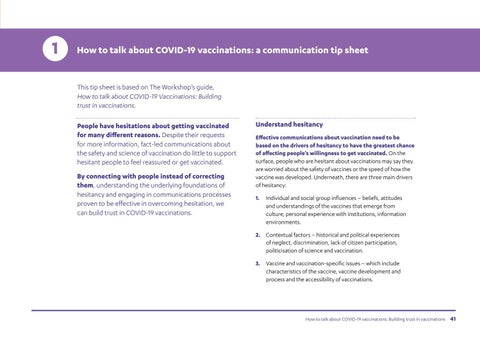1
How to talk about COVID-19 vaccinations: a communication tip sheet
This tip sheet is based on The Workshop’s guide, How to talk about COVID-19 Vaccinations: Building trust in vaccinations. People have hesitations about getting vaccinated for many different reasons. Despite their requests for more information, fact-led communications about the safety and science of vaccination do little to support hesitant people to feel reassured or get vaccinated. By connecting with people instead of correcting them, understanding the underlying foundations of hesitancy and engaging in communications processes proven to be effective in overcoming hesitation, we can build trust in COVID-19 vaccinations.
Understand hesitancy Effective communications about vaccination need to be based on the drivers of hesitancy to have the greatest chance of affecting people’s willingness to get vaccinated. On the surface, people who are hesitant about vaccinations may say they are worried about the safety of vaccines or the speed of how the vaccine was developed. Underneath, there are three main drivers of hesitancy: 1. Individual and social group influences – beliefs, attitudes and understandings of the vaccines that emerge from culture, personal experience with institutions, information environments. 2. Contextual factors – historical and political experiences of neglect, discrimination, lack of citizen participation, politicisation of science and vaccination. 3. Vaccine and vaccination-specific issues – which include characteristics of the vaccine, vaccine development and process and the accessibility of vaccinations.
How to talk about COVID-19 vaccinations: Building trust in vaccinations
41










